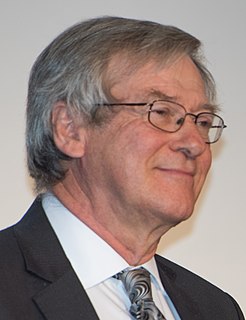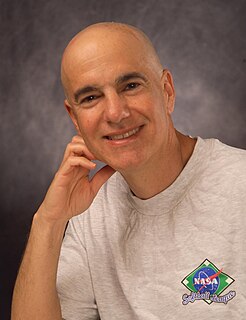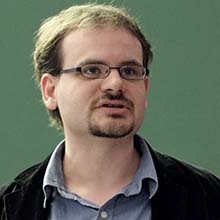Related Research Articles

Sandra Moore Faber is an astrophysicist known for her research on the evolution of galaxies. She is the University Professor of Astronomy and Astrophysics at the University of California, Santa Cruz, and works at the Lick Observatory. She has made important discoveries linking the brightness of galaxies to the speed of stars within them and was the co-discoverer of the Faber–Jackson relation. Faber was also instrumental in designing the Keck telescopes in Hawaii.

The American Astronomical Society is an American society of professional astronomers and other interested individuals, headquartered in Washington, DC. The primary objective of the AAS is to promote the advancement of astronomy and closely related branches of science, while the secondary purpose includes enhancing astronomy education and providing a political voice for its members through lobbying and grassroots activities. Its current mission is to enhance and share humanity's scientific understanding of the universe.
Eleanor Margaret Burbidge, FRS (néePeachey; 12 August 1919 – 5 April 2020) was a British-American observational astronomer and astrophysicist. In the 1950s, she was one of the founders of stellar nucleosynthesis and was first author of the influential B2FH paper. During the 1960s and 70s she worked on galaxy rotation curves and quasars, discovering the most distant astronomical object then known. In the 1980s and 90s she helped develop and utilise the Faint Object Spectrograph on the Hubble Space Telescope. Burbidge was well known for her work opposing discrimination against women in astronomy.

William Lassell was an English merchant and astronomer. He is remembered for his improvements to the reflecting telescope and his ensuing discoveries of four planetary satellites.

WASP or Wide Angle Search for Planets is an international consortium of several academic organisations performing an ultra-wide angle search for exoplanets using transit photometry. The array of robotic telescopes aims to survey the entire sky, simultaneously monitoring many thousands of stars at an apparent visual magnitude from about 7 to 13.

Delta Cephei is the Bayer designation for a quadruple star system located approximately 887 light-years away in the northern circumpolar constellation of Cepheus, the King. At this distance, the visual magnitude of the star is diminished by 0.23 as a result of extinction caused by gas and dust along the line of sight. It is the prototype of the Cepheid variable stars that undergo periodic changes in luminosity.
HD 69830 is a yellow dwarf star located approximately 41 light-years away in the constellation of Puppis. In 2005, the Spitzer Space Telescope discovered a narrow ring of warm debris orbiting the star. The debris ring contains substantially more dust than the Solar System's asteroid belt. In 2006, three extrasolar planets with minimum masses comparable to Neptune were confirmed in orbit around the star, located interior to the debris ring.
Gamma Doradus variables are variable stars which display variations in luminosity due to non-radial pulsations of their surface. The stars are typically young, early F or late A type main sequence stars, and typical brightness fluctuations are 0.1 magnitudes with periods on the order of one day. This class of variable stars is relatively new, having been first characterized in the second half of the 1990s, and details on the underlying physical cause of the variations remains under investigation.
Doris Daou is a Lebanese-born astronomer from Canada who was formerly the Director for Education and Public Outreach of the NASA Lunar Science Institute and the Associate Director of the NASA Solar System Exploration Research Virtual Institute (SSERVI), and is currently the program contact for NASA's "Small Innovative Missions for Planetary Exploration (SIMPLEx)".
Psi Centauri, which is Latinized from ψ Centauri, is a binary star system in the southern constellation of Centaurus. It is visible to the naked eye with a baseline apparent visual magnitude of +4.05. The distance to this system is approximately 259 light years based on parallax. The radial velocity is poorly constrained, but it appears to be slowly drifting away from the Sun at the rate of +2 km/s.

Roger David Blandford, FRS, FRAS is a British theoretical astrophysicist, best known for his work on black holes.

Heidi B. Hammel is a planetary astronomer who has extensively studied Neptune and Uranus. She was part of the team imaging Neptune from Voyager 2 in 1989. She led the team using the Hubble Space Telescope to view Shoemaker-Levy 9's impact with Jupiter in 1994. She has used the Hubble Space Telescope and the Keck Telescope to study Uranus and Neptune, discovering new information about dark spots, planetary storms and Uranus' rings. In 2002, she was selected as an interdisciplinary scientist for the James Webb Space Telescope.

Neptune is the eighth and farthest-known Solar planet from the Sun. In the Solar System, it is the fourth-largest planet by diameter, the third-most-massive planet, and the densest giant planet. It is 17 times the mass of Earth, slightly more massive than its near-twin Uranus. Neptune is denser and physically smaller than Uranus because its greater mass causes more gravitational compression of its atmosphere. The planet orbits the Sun once every 164.8 years at an average distance of 30.1 AU. It is named after the Roman god of the sea and has the astronomical symbol ♆, a stylised version of the god Neptune's trident.
Philip D. Nicholson is an Australian-born professor of astronomy at Cornell University in the Astronomy department specialising in Planetary Sciences. He has been editor-in-chief of the journal Icarus since 1998.
Sarah Lee Lippincott, also known as Sarah Lee Lippincott Zimmerman, was an American astronomer. She was professor emerita of astronomy at Swarthmore College and director emerita of the college's Sproul Observatory. She was a pioneer in the use of astrometry to determine the character of binary stars and search for extrasolar planets.

Jack Jonathan Lissauer is an American research scientist who has worked for NASA's Ames Research Center since 1996. He is a science co-investigator on the Kepler space telescope mission.

Pieter Timotheus "Tim" de Zeeuw is a Dutch astronomer specializing in the formation, structure and dynamics of galaxies.

Christopher J. Conselice is an American astrophysicist who is currently a Professor of Astrophysics at the University of Manchester.
Lennox Lauchlan Cowie FRS is a British astronomer, and professor at the Institute for Astronomy, University of Hawaii.
Sidney Carne Wolff is an American astrophysicist, researcher, public educator, and author. She is the first woman in the United States to head a major observatory, and she provided significant contributions to the construction of six telescopes. Wolff served as Director of the Kitt Peak National Observatory (KPNO) and the National Optical Astronomy Observatory (NOAO). She is a member of the International Astronomical Union's Division G: Stars and Stellar Physics.
References
- ↑ John Noble Wilford (1982-06-10). "Data Shows 2 Rings Circling Neptune". Archives, The New York Times (June 10, 1982). Retrieved 2007-06-28.
- ↑ Guinan, E. F.; Harris, C. C.; Maloney, F. P. (1982). "Evidence for a Ring System on Neptune" (PDF). Abstracts, Astronomy ADS. 14: 658. Bibcode:1982BAAS...14..658G . Retrieved 2007-06-28.
- ↑ Faye Flam. "Hunt is on for another planet Earth". The Philadelphia Inquirer (June 6, 2009). Retrieved 7 July 2009.[ dead link ]
- ↑ "Faculty in the News". E-Newsletter, Villanova University (March 2008). Retrieved 7 July 2009.
- ↑ "AAS Fellows". AAS. Retrieved 28 September 2020.